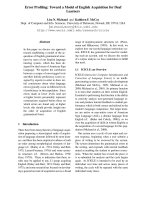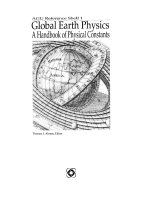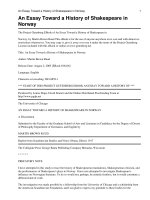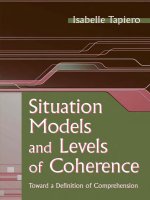- Trang chủ >>
- Khoa Học Tự Nhiên >>
- Vật lý
Geometric mechanics toward a unification of classical physics
Bạn đang xem bản rút gọn của tài liệu. Xem và tải ngay bản đầy đủ của tài liệu tại đây (3.8 MB, 606 trang )
Richard Talman
Geometric Mechanics
www.pdfgrip.com
1807–2007 Knowledge for Generations
Each generation has its unique needs and aspirations. When Charles Wiley first
opened his small printing shop in lower Manhattan in 1807, it was a generation
of boundless potential searching for an identity. And we were there, helping to
define a new American literary tradition. Over half a century later, in the midst
of the Second Industrial Revolution, it was a generation focused on building
the future. Once again, we were there, supplying the critical scientific, technical,
and engineering knowledge that helped frame the world. Throughout the 20th
Century, and into the new millennium, nations began to reach out beyond their
own borders and a new international community was born. Wiley was there, expanding its operations around the world to enable a global exchange of ideas,
opinions, and know-how.
For 200 years, Wiley has been an integral part of each generation’s journey,
enabling the flow of information and understanding necessary to meet their
needs and fulfill their aspirations. Today, bold new technologies are changing
the way we live and learn. Wiley will be there, providing you the must-have
knowledge you need to imagine new worlds, new possibilities, and new opportunities.
Generations come and go, but you can always count on Wiley to provide you
the knowledge you need, when and where you need it!
William J. Pesce
President and Chief Executive Officer
Peter Booth Wiley
Chairman of the Board
www.pdfgrip.com
Richard Talman
Geometric Mechanics
Toward a Unification of Classical Physics
Second, Revised and Enlarged Edition
WILEY-VCH Verlag GmbH & Co. KGaA
www.pdfgrip.com
The Author
Prof. Richard Talman
Cornell University
Laboratory of Elementary Physics
Ithaca, NY 14853
USA
All books published by Wiley-VCH are carefully
produced. Nevertheless, authors, editors, and
publisher do not warrant the information
contained in these books, including this book, to
be free of errors. Readers are advised to keep in
mind that statements, data, illustrations,
procedural details or other items may
inadvertently be inaccurate.
Library of Congress Card No.:
applied for
British Library Cataloguing-in-Publication
Data
A catalogue record for this book is available from
the British Library.
Bibliographic information published by
the Deutsche Nationalbibliothek
The Deutsche Nationalbibliothek lists this
publication in the Deutsche Nationalbibliografie;
detailed bibliographic data are available in the
Internet at <>.
2007 WILEY-VCH Verlag GmbH & Co. KGaA,
Weinheim
All rights reserved (including those of translation
into other languages). No part of this book may be
reproduced in any form – by photoprinting,
microfilm, or any other means – nor transmitted or
translated into a machine language without
written permission from the publishers.
Registered names, trademarks, etc. used in this
book, even when not specifically marked as such,
are not to be considered unprotected by law.
Composition Uwe Krieg, Berlin
Printing Strauss GmbH, Mörlenbach
Binding Litges & Dopf Buchbinderei GmbH,
Heppenheim
Wiley Bicentennial Logo Richard J. Pacifico
Printed in the Federal Republic of Germany
Printed on acid-free paper
ISBN: 978-3-527-40683-8
www.pdfgrip.com
V
Contents
Preface
XV
Introduction 1
Bibliography 9
1
Review of Classical Mechanics and String Field Theory 11
1.1
1.2
1.2.1
1.3
1.4
1.4.1
1.4.2
1.4.3
1.5
1.6
1.7
1.7.1
1.7.2
1.8
1.9
1.10
1.11
Preview and Rationale 11
Review of Lagrangians and Hamiltonians 13
Hamilton’s Equations in Multiple Dimensions 14
Derivation of the Lagrange Equation from Hamilton’s Principle 16
Linear, Multiparticle Systems 18
The Laplace Transform Method 23
Damped and Driven Simple Harmonic Motion 24
Conservation of Momentum and Energy 26
Effective Potential and the Kepler Problem 26
Multiparticle Systems 29
Longitudinal Oscillation of a Beaded String 32
Monofrequency Excitation 33
The Continuum Limit 34
Field Theoretical Treatment and Lagrangian Density 36
Hamiltonian Density for Transverse String Motion 39
String Motion Expressed as Propagating and Reflecting Waves 40
Problems 42
Bibliography 44
45
2
Geometry of Mechanics, I, Linear
2.1
2.2
2.2.1
2.2.2
2.2.3
Pairs of Planes as Covariant Vectors 47
Differential Forms 53
Geometric Interpretation 53
Calculus of Differential Forms 57
Familiar Physics Equations Expressed Using Differential Forms 61
www.pdfgrip.com
VI
Contents
2.3
2.3.1
2.3.2
2.3.3
2.3.4
2.3.5
2.4
2.4.1
2.4.2
2.4.3
2.4.4
2.4.5
Algebraic Tensors 66
Vectors and Their Duals 66
Transformation of Coordinates 68
Transformation of Distributions 72
Multi-index Tensors and their Contraction 73
Representation of a Vector as a Differential Operator 76
(Possibly Complex) Cartesian Vectors in Metric Geometry 79
Euclidean Vectors 79
Skew Coordinate Frames 81
Reduction of a Quadratic Form to a Sum or Difference of
Squares 81
Introduction of Covariant Components 83
The Reciprocal Basis 84
Bibliography 86
89
3
Geometry of Mechanics, II, Curvilinear
3.1
3.1.1
3.1.2
3.1.3
3.2
(Real) Curvilinear Coordinates in n-Dimensions 90
The Metric Tensor 90
Relating Coordinate Systems at Different Points in Space 92
The Covariant (or Absolute) Differential 97
Derivation of the Lagrange Equations from the Absolute
Differential 102
Practical Evaluation of the Christoffel Symbols 108
Intrinsic Derivatives and the Bilinear Covariant 109
The Lie Derivative – Coordinate Approach 111
Lie-Dragged Coordinate Systems 111
Lie Derivatives of Scalars and Vectors 115
The Lie Derivative – Lie Algebraic Approach 120
Exponential Representation of Parameterized Curves 120
Identification of Vector Fields with Differential Operators 121
Loop Defect 122
Coordinate Congruences 123
Lie-Dragged Congruences and the Lie Derivative 125
Commutators of Quasi-Basis-Vectors 130
Bibliography 132
3.2.1
3.3
3.4
3.4.1
3.4.2
3.5
3.5.1
3.6
3.6.1
3.7
3.8
3.9
133
4
Geometry of Mechanics, III, Multilinear
4.1
4.1.1
4.1.2
4.1.3
4.2
Generalized Euclidean Rotations and Reflections 133
Reflections 134
Expressing a Rotation as a Product of Reflections 135
The Lie Group of Rotations 136
Multivectors 138
www.pdfgrip.com
Contents
4.2.1
4.2.2
4.2.3
4.2.4
4.2.5
4.2.6
4.2.7
4.3
4.3.1
4.3.2
4.3.3
4.3.4
4.3.5
4.3.6
4.4
4.4.1
4.4.2
4.4.3
4.4.4
4.4.5
4.4.6
4.4.7
4.4.8
4.4.9
Volume Determined by 3- and by n-Vectors 138
Bivectors 140
Multivectors and Generalization to Higher Dimensionality 141
Local Radius of Curvature of a Particle Orbit 143
“Supplementary” Multivectors 144
Sums of p-Vectors 145
Bivectors and Infinitesimal Rotations 145
Curvilinear Coordinates in Euclidean Geometry (Continued) 148
Repeated Exterior Derivatives 148
The Gradient Formula of Vector Analysis 149
Vector Calculus Expressed by Differential Forms 151
Derivation of Vector Integral Formulas 154
Generalized Divergence and Gauss’s Theorem 157
Metric-Free Definition of the “Divergence” of a Vector 159
Spinors in Three-Dimensional Space 161
Definition of Spinors 162
Demonstration that a Spinor is a Euclidean Tensor 162
Associating a 2 × 2 Reflection (Rotation) Matrix with a Vector
(Bivector) 163
Associating a Matrix with a Trivector (Triple Product) 164
Representations of Reflections 164
Representations of Rotations 165
Operations on Spinors 166
Real Euclidean Space 167
Real Pseudo-Euclidean Space 167
Bibliography 167
5
Lagrange–Poincaré Description of Mechanics 169
5.1
5.1.1
5.1.2
5.1.3
5.1.4
5.2
5.3
5.3.1
5.3.2
5.3.3
5.3.4
5.3.5
5.3.6
5.3.7
The Poincaré Equation 169
Some Features of the Poincaré Equations 179
Invariance of the Poincaré Equation 180
Translation into the Language of Forms and Vector Fields 182
Example: Free Motion of a Rigid Body with One Point Fixed 183
Variational Derivation of the Poincaré Equation 186
Restricting the Poincaré Equation With Group Theory 189
Continuous Transformation Groups 189
Use of Infinitesimal Group Parameters as Quasicoordinates 193
Infinitesimal Group Operators 195
Commutation Relations and Structure Constants of the Group 199
Qualitative Aspects of Infinitesimal Generators 201
The Poincaré Equation in Terms of Group Generators 204
The Rigid Body Subject to Force and Torque 206
Bibliography 217
www.pdfgrip.com
VII
VIII
Contents
6
6.1
6.1.1
6.1.2
6.1.3
6.1.4
6.2
6.2.1
6.2.2
6.2.3
6.2.4
6.3
6.3.1
6.3.2
6.3.3
6.3.4
6.3.5
6.4
6.4.1
6.4.2
6.4.3
6.5
Newtonian/Gauge Invariant Mechanics
Vector Mechanics 219
219
Vector Description in Curvilinear Coordinates 219
The Frenet–Serret Formulas 222
Vector Description in an Accelerating Coordinate Frame 226
Exploiting the Fictitious Force Description 232
Single Particle Equations in Gauge Invariant Form 238
Newton’s Force Equation in Gauge Invariant Form 239
Active Interpretation of the Transformations 242
Newton’s Torque Equation 246
The Plumb Bob 248
Gauge Invariant Description of Rigid Body Motion 252
Space and Body Frames of Reference 253
Review of the Association of 2 × 2 Matrices to Vectors 256
“Association” of 3 × 3 Matrices to Vectors 258
Derivation of the Rigid Body Equations 259
The Euler Equations for a Rigid Body 261
The Foucault Pendulum 262
Fictitious Force Solution 263
Gauge Invariant Solution 265
“Parallel” Translation of Coordinate Axes 270
Tumblers and Divers 274
Bibliography 276
277
7
Hamiltonian Treatment of Geometric Optics
7.1
7.1.1
7.1.2
7.1.3
7.1.4
7.2
7.2.1
7.2.2
7.3
7.4
Analogy Between Mechanics and Geometric Optics 278
Scalar Wave Equation 279
The Eikonal Equation 281
Determination of Rays from Wavefronts 282
The Ray Equation in Geometric Optics 283
Variational Principles 285
The Lagrange Integral Invariant and Snell’s Law 285
The Principle of Least Time 287
Paraxial Optics, Gaussian Optics, Matrix Optics 288
Huygens’ Principle 292
Bibliography 294
8
Hamilton–Jacobi Theory 295
8.1
8.1.1
8.1.2
8.2
Hamilton–Jacobi Theory Derived from Hamilton’s Principle 295
The Geometric Picture 297
Constant S Wavefronts 298
Trajectory Determination Using the Hamilton–Jacobi Equation 299
www.pdfgrip.com
Contents
8.2.1
8.2.2
8.2.3
8.2.4
8.2.5
8.2.6
8.2.7
8.3
8.3.1
8.3.2
8.3.3
8.4
8.4.1
Complete Integral 299
Finding a Complete Integral by Separation of Variables 300
Hamilton–Jacobi Analysis of Projectile Motion 301
The Jacobi Method for Exploiting a Complete Integral 302
Completion of Projectile Example 304
The Time-Independent Hamilton–Jacobi Equation 305
Hamilton–Jacobi Treatment of 1D Simple Harmonic Motion 306
The Kepler Problem 307
Coordinate Frames 308
Orbit Elements 309
Hamilton–Jacobi Formulation. 310
Analogies Between Optics and Quantum Mechanics 314
Classical Limit of the Schrödinger Equation 314
Bibliography 316
317
9
Relativistic Mechanics
9.1
9.1.1
9.1.2
9.1.3
9.1.4
9.1.5
9.1.6
9.1.7
9.1.8
9.1.9
9.2
9.2.1
9.2.2
9.2.3
9.2.4
9.2.5
9.3
Relativistic Kinematics 317
Form Invariance 317
World Points and Intervals 318
Proper Time 319
The Lorentz Transformation 321
Transformation of Velocities 322
4-Vectors and Tensors 322
Three-Index Antisymmetric Tensor 325
Antisymmetric 4-Tensors 325
The 4-Gradient, 4-Velocity, and 4-Acceleration 326
Relativistic Mechanics 327
The Relativistic Principle of Least Action 327
Energy and Momentum 328
4-Vector Notation 329
Forced Motion 329
Hamilton–Jacobi Formulation 330
Introduction of Electromagnetic Forces into Relativistic
Mechanics 332
Generalization of the Action 332
Derivation of the Lorentz Force Law 334
Gauge Invariance 335
Bibliography 338
9.3.1
9.3.2
9.3.3
10
Conservation Laws and Symmetry 339
10.1
10.2
Conservation of Linear Momentum 339
Rate of Change of Angular Momentum: Poincaré Approach 341
www.pdfgrip.com
IX
X
Contents
10.3
10.4
10.5
10.5.1
10.6
10.7
10.7.1
10.8
10.8.1
10.8.2
10.9
10.10
Conservation of Angular Momentum: Lagrangian Approach 342
Conservation of Energy 343
Cyclic Coordinates and Routhian Reduction 344
Integrability; Generalization of Cyclic Variables 347
Noether’s Theorem 348
Conservation Laws in Field Theory 352
Ignorable Coordinates and the Energy Momentum Tensor 352
Transition From Discrete to Continuous Representation 356
The 4-Current Density and Charge Conservation 356
Energy and Momentum Densities 360
Angular Momentum of a System of Particles 362
Angular Momentum of a Field 363
Bibliography 364
11
Electromagnetic Theory 365
11.1
11.1.1
11.1.2
11.2
11.2.1
11.2.2
11.2.3
11.2.4
11.2.5
The Electromagnetic Field Tensor 367
The Lorentz Force Equation in Tensor Notation 367
Lorentz Transformation and Invariants of the Fields 369
The Electromagnetic Field Equations 370
The Homogeneous Pair of Maxwell Equations 370
The Action for the Field, Particle System 370
The Electromagnetic Wave Equation 372
The Inhomogeneous Pair of Maxwell Equations 373
Energy Density, Energy Flux, and the Maxwell Stress Energy
Tensor 374
Bibliography 377
12
Relativistic Strings 379
Introduction 379
12.1
12.1.1
12.1.2
12.1.3
12.2
12.3
12.3.1
12.3.2
12.3.3
12.3.4
12.4
12.5
12.6
Is String Theory Appropriate? 379
Parameterization Invariance 381
Postulating a String Lagrangian 381
Area Representation in Terms of the Metric 383
The Lagrangian Density and Action for Strings 384
A Revised Metric 384
Parameterization of String World Surface by σ and τ 385
The Nambu–Goto Action 385
String Tension and Mass Density 387
Equations of Motion, Boundary Conditions, and Unexcited
Strings 389
The Action in Terms of Transverse Velocity 391
Orthogonal Parameterization by Energy Content 394
www.pdfgrip.com
Contents
12.7
12.8
12.9
12.9.1
12.10
12.11
General Motion of a Free Open String 396
A Rotating Straight String 398
Conserved Momenta of a String 400
Angular Momentum of Uniformly Rotating Straight String
Light Cone Coordinates 402
Oscillation Modes of a Relativistic String 406
Bibliography 408
401
409
13
General Relativity
13.1
13.2
13.3
13.3.1
13.4
13.5
13.5.1
Introduction 409
Transformation to Locally Inertial Coordinates 412
Parallel Transport on a Surface 413
Geodesic Curves 416
The Twin Paradox in General Relativity 417
The Curvature Tensor 422
Properties of Curvature Tensor, Ricci Tensor, and Scalar
Curvature 423
The Lagrangian of General Relativity and the Energy–Momentum
Tensor 425
“Derivation” of the Einstein Equation 428
Weak, Nonrelativistic Gravity 430
The Schwarzschild Metric 433
Orbit of a Particle Subject to the Schwarzschild Metric 434
Gravitational Lensing and Red Shifts 437
Bibliography 440
13.6
13.7
13.8
13.9
13.9.1
13.10
14
Analytic Bases for Approximation 441
14.1
14.1.1
14.2
14.3
14.3.1
14.3.2
14.3.3
14.3.4
14.4
14.4.1
14.4.2
14.4.3
14.5
14.6
14.6.1
Canonical Transformations 441
The Action as a Generator of Canonical Transformations 441
Time-Independent Canonical Transformation 446
Action-Angle Variables 448
The Action Variable of a Simple Harmonic Oscillator 448
Adiabatic Invariance of the Action I 449
Action/Angle Conjugate Variables 453
Parametrically Driven Simple Harmonic Motion 455
Examples of Adiabatic Invariance 457
Variable Length Pendulum 457
Charged Particle in Magnetic Field 459
Charged Particle in a Magnetic Trap 461
Accuracy of Conservation of Adiabatic Invariants 466
Conditionally Periodic Motion 469
Stäckel’s Theorem 470
www.pdfgrip.com
XI
XII
Contents
14.6.2
14.6.3
Angle Variables 471
Action/Angle Coordinates for Keplerian Satellites
Bibliography 475
474
477
15
Linear Hamiltonian Systems
15.1
15.1.1
15.1.2
Linear Hamiltonian Systems 477
Inhomogeneous Equations 479
Exponentiation, Diagonalization, and Logarithm Formation of
Matrices 479
Alternate Coordinate Ordering 481
Eigensolutions 481
Periodic Linear Systems 484
Floquet’s Theorem 485
Lyapunov’s Theorem 487
Characteristic Multipliers, Characteristic Exponents 487
The Variational Equations 489
Bibliography 490
15.1.3
15.1.4
15.2
15.2.1
15.2.2
15.2.3
15.2.4
16
Perturbation Theory 491
16.1
16.1.1
16.1.2
16.2
16.3
16.4
16.4.1
16.4.2
16.4.3
16.4.4
16.4.5
16.5
16.5.1
16.5.2
16.5.3
The Lagrange Planetary Equations 492
Derivation of the Equations 492
Relation Between Lagrange and Poisson Brackets 496
Advance of Perihelion of Mercury 497
Iterative Analysis of Anharmonic Oscillations 502
The Method of Krylov and Bogoliubov 508
First Approximation 508
Equivalent Linearization 512
Power Balance, Harmonic Balance 514
Qualitative Analysis of Autonomous Oscillators 515
Higher K–B Approximation 518
Superconvergent Perturbation Theory 523
Canonical Perturbation Theory 523
Application to Gravity Pendulum 525
Superconvergence 527
Bibliography 527
529
17
Symplectic Mechanics
17.1
17.1.1
17.1.2
17.1.3
17.1.4
The Symplectic Properties of Phase Space 530
The Canonical Momentum 1-Form 530
The Symplectic 2-Form ω 533
Invariance of the Symplectic 2-Form 537
Use of ω to Associate Vectors and 1-Forms 538
www.pdfgrip.com
Contents
17.1.5
Explicit Evaluation of Some Inner Products 539
17.1.6
17.1.7
17.2
17.2.1
17.2.2
17.2.3
17.3
17.3.1
17.3.2
17.3.3
17.4
17.4.1
17.4.2
17.5
17.5.1
17.5.2
17.6
17.6.1
The Vector Field Associated with dH 540
Hamilton’s Equations in Matrix Form 541
Symplectic Geometry 543
Symplectic Products and Symplectic Bases 543
Symplectic Transformations 545
Properties of Symplectic Matrices 546
Poisson Brackets of Scalar Functions 554
The Poisson Bracket of Two Scalar Functions 554
Properties of Poisson Brackets 555
The Poisson Bracket and Quantum Mechanics 555
Integral Invariants 557
Integral Invariants in Electricity and Magnetism 557
The Poincaré–Cartan Integral Invariant 560
Invariance of the Poincaré–Cartan Integral Invariant I.I. 562
The Extended Phase Space 2-Form and its Special Eigenvector 563
Proof of Invariance of the Poincaré Relative Integral Invariant 565
Symplectic System Evolution 566
Liouville’s Theorem and Generalizations 568
Bibliography 570
Index 571
www.pdfgrip.com
XIII
www.pdfgrip.com
XV
Preface
This text is designed to accompany a junior/senior or beginning graduate
student course in mechanics for students who have already encountered Lagrange’s equations. As the title Geometric Mechanics indicates, the content is
classical mechanics, with emphasis on geometric methods, such as differential
geometry, tensor analysis, and group theory. Courses for which the material
in the text has been used and is appropriate are discussed in the Introduction. To reflect a substantial new emphasis in this second edition, compared
to the first, the subtitle “Toward a Unification of Classical Physics” has been
added. Instead of just laying the groundwork for follow-on, geometry-based,
physics subjects, especially general relativity and string theory, this edition
contains substantial introductions to both of those topics. To support this,
introductory material on classical field theory, including electrodynamic theory (also formulated as mechanics) has been included. The purpose of these
“other physics” chapters is to show how, based on Hamilton’s principle of
least action, all, or at least most, of classical physics is naturally subsumed
into classical mechanics.
Communications pointing out errors, or making comments or suggestions
will be appreciated; E-mail address; Because
of its complete reorganization, there are undoubtedly more minor errors and
dangling references than might be expected for a second edition.
The institutions contributing (in equal parts) to this text have been the public schools of London, Ontario, and universities U.W.O., Caltech, and Cornell.
I have profited, initially as a student, and later from my students, at these institutions, and from my colleagues there and at accelerator laboratories worldwide. I have also been fortunate of family; parents, brother, children, and,
especially my wife, Myrna.
Ithaca, New York
May, 2007
Richard Talman
www.pdfgrip.com
www.pdfgrip.com
1
Introduction
The first edition of this text was envisaged as a kind of Mathematical Methods
of Classical Mechanics for Pedestrians, with geometry playing a more important
role than in the traditional pedagogy of classical mechanics. Part of the rationale was to prepare the student for subsequent geometry-intensive physics
subjects, especially general relativity. Subsequently I have found that, as a
text for physics courses, this emphasis was somewhat misplaced. (Almost by
definition) students of physics want to learn “physics” more than they want
to learn “applied mathematics.” Consistent with this, there has been a tendency for classical mechanics to be squeezed out of physics curricula in favor
of general relativity or, more recently, string theory. This second edition has
been revised accordingly. Instead of just laying the groundwork for subjects
such as electromagnetic theory, string theory, and general relativity, it subsumes these subjects into classical mechanics. After these changes, the text
has become more nearly a Classical Theory of Fields for Pedestrians.
Geometric approaches have contributed importantly to the evolution of
modern physical theories. The best example is general relativity; the most
modern example is string theory. In fact general relativity and string theory
are the theories for which the adjective “geometric” is most unambiguously
appropriate. There is now a chapter on each of these subjects in this text,
along with material on (classical) field theory basic to these subjects. Also,
because electromagnetic theory fits the same template, and is familiar to most
students, that subject is here also formulated as a “branch” of classical mechanics.
In grandiose terms, the plan of the text is to arrogate to classical mechanics
all of classical physics, where “classical” means nonquantum-mechanical and
“all” means old-fashioned classical mechanics plus the three physical theories
mentioned previously. Other classical theories, such as elasticity and hydrodynamics, can be regarded as having already been subsumed into classical
mechanics, but they lie outside the scope of this text.
In more technical terms, the theme of the text is that all of classical physics
starts from a Lagrangian, continues with Hamilton’s principle (also known
www.pdfgrip.com
2
Introduction
as the principle of least action) and finishes with solving the resultant equations and comparison with experiment. This program provides a unification
of classical physics. General principles, especially symmetry and special relativity, limit the choices surprisingly when any new term is to be added to the
Lagrangian. Once a new term has been added the entire theory and its predictions are predetermined. These results can then be checked experimentally.
The track record for success in this program has been astonishingly good. As
far as classical physics is concerned the greatest triumphs are due to Maxwell
and Einstein. The philosophic basis for this approach, apparently espoused
by Einstein, is not that we live in the best of all possible worlds, but that we
live in the only possible world. Even people who find this philosophy silly
find that you don’t have to subscribe to this philosophy for the approach to
work well.
There is an ambitious program in quantum field theory called “grand unification” of the four fundamental forces of physics. The present text can be regarded as preparation for this program in that it describes classical physics in
ways consistent with this eventual approach. As far as I know, any imagined
grand unification scheme will, when reduced to the classical level, resemble
the material presented here. (Of course most of the essence of the physics is
quantum mechanical and cannot survive the reduction to classical physics.)
Converting the emphasis from applied mathematics to pure physics required fewer changes to the text than might be supposed. Much of the earlier book emphasized specialized mathematics and computational descriptions that could be removed to make room for the “physics” chapters already
mentioned. By no means does this mean that the text has been gutted of practical worked examples of classical mechanics. For example, most of the long
chapters on perturbation theory and on the application of adiabatic invariants
(both of which are better thought of as physics than as mathematics) have
been retained. All of the (admittedly unenthusiastic) discussion of canonical
transformation methods has also been retained.
Regrettably, some material on the boundary between classical and quantum mechanics has had to be dropped. As well as helping to keep the book
length within bounds, this deletion was consistent with religiously restricting
the subject matter to nothing but classical physics. There was a time when classical Hamiltonian mechanics seemed like the best introduction to quantum
mechanics but, like the need to study Latin in school, that no longer seems to
be the case. Also, apart from its connections to the Hamilton–Jacobi theory
(which every educated physicist has to understand) quantum mechanics is
not very geometric in character. It was relatively painless therefore, to remove
unitary geometry, Bragg scattering (illustrating the use of covariant tensors),
and other material on the margin between classical and quantum mechanics.
www.pdfgrip.com
Introduction
In this book’s first manifestation the subject of mechanics was usefully, if
somewhat artificially, segmented into Lagrangian, Hamiltonian, and Newtonian formulations. Much was made of Poincaré’s extension to the Lagrangian
approach. Because this approach advances the math more than the physics, it
now has had to be de-emphasized (though most of the material remains). On
the other hand, as mentioned already, the coverage of Lagrangian field theory,
and especially its conservation laws, needed to be expanded. Reduced weight
also had to be assigned to Hamiltonian methods (not counting Hamilton’s
principle.) Those methods provide the most direct connections to quantum
mechanics but, with quantum considerations now being ignored, they are less
essential to the program. Opposite comments apply to Newtonian methods,
which stress fictitious forces (centrifugal and Coriolis), ideas that led naturally
to general relativity. Gauge invariant methods, which play such an important
role in string theory, are also naturally introduced in the context of direct Newtonian methods. The comments in this paragraph, taken together, repudiate
much of the preface to the first edition which has, therefore, been discarded.
Everything contained in this book is explained with more rigor, or more
depth, or more detail, or (especially) more sophistication, in at least one of the
books listed at the end of this introduction. Were it not for the fact that most
of those books are fat, intimidating, abstract, formal, mathematical and (for
many) unintelligible, the reader’s time would be better spent reading them
(in the right order) than studying this book. But if this text renders books like
these both accessible and admirable, it will have achieved its main purpose. It
has been said that bridge is a simple game; dealt thirteen cards, one has only
to play them in the correct order. In the same sense mechanics is easy to learn;
one simply has to study readily available books in a sensible order. I have tried
to chart such a path, extracting material from various sources in an order that I
have found appropriate. At each stage I indicate (at the end of the chapter) the
reference my approach most closely resembles. In some cases what I provide
is a kind of Reader’s Digest of a more general treatment and this may amount
to my having systematically specialized and made concrete, descriptions that
the original author may earlier have systematically labored to generalize and
make abstract. The texts to which these statements are most applicable are
listed at the end of each chapter, and keyed to the particular section to which
they relate. It is not suggested that these texts should be systematically referred to as they tend to be advanced and contain much unrelated material.
But if particular material in this text is obscure, or seems to stop short of some
desirable goal, these texts should provide authoritative help.
Not very much is original in the text other than the selection and arrangement of the topics and the style of presentation. Equations (though not text)
have been “borrowed,” in some cases verbatim, from various sources. This
is especially true of Chapters 9, on special relativity, 11, on electromagnetic
www.pdfgrip.com
3
4
Introduction
theory, and 13, on general relativity. These chapters follow Landau and Lifschitz quite closely. Similarly, Chapter 12 follows Zwiebach closely. There
are also substantial sections following Cartan, or Arnold, or others. As well
as occasional reminders in the text, of these sources, the bibliography at the
end of each chapter lists the essential sources. Under “General References”
are books, like the two just mentioned, that contain one or more chapters discussing much the same material in at least as much, and usually far more,
detail, than is included here. These references could be used instead of the
material in the chapter they are attached to, and should be used to go deeper
into the subject. Under “References for Further Study” are sources that can
be used as well as the material of the chapter. In principle, none of these references should actually be necessary, as the present text is supposed to be
self-sufficient. In practice, obscurities and the likelihood of errors or misunderstandings, make it appropriate, or even necessary, to refer to other sources
to obtain anything resembling a deep understanding of a topic.
The mathematical level strived for is only high enough to support a persuasive (to a nonmathematician) trip through the physics. Still, “it can be shown
that” almost never appears, though the standards of what constitutes “proof”
may be low, and the range of generality narrow. I believe that much mathematics is made difficult for the less-mathematically-inclined reader by the absence of concrete instances of the abstract objects under discussion. This text
tries to provide essentially correct instances of otherwise hard to grasp mathematical abstractions. I hope and believe that this will provide a broad base
of general understanding from which deeper, more specialized, more mathematical texts can be approached with a respectable general comprehension.
This statement is most applicable to the excellent books by Arnold, who tries
hard, but not necessarily successfully, to provide physical lines of reasoning.
Much of this book was written with the goal of making one or another of his
discussions comprehensible.
In the early days of our weekly Laboratory of Nuclear Studies Journal Club,
our founding leader, Robert Wilson, imposed a rule – though honored as much
in the breach as in the observance, it was not intended to be a joke – that the
Dirac γ-matrices never appear. The (largely unsuccessful) purpose of this rule
was to force the lectures to be intelligible to us theory-challenged experimentalists. In this text there is a similar rule. It is that hieroglyphics such as
φ : { x ∈ R2 : | x | = 1} → R
not appear. The justification for this rule is that a “physicist” is likely to skip
such a statement altogether or, once having understood it, regard it as obvious. Like the jest that the French “don’t care what they say as long as they
pronounce it properly” one can joke that mathematicians don’t care what
their mappings do, as long as the spaces they connect are clear. Physicists,
www.pdfgrip.com
Introduction
on the other hand, care primarily what their functions represent physically
and are not fussy about what spaces they relate. Another “rule” has just been
followed; the word function will be used in preference to the (synonymous)
word mapping. Other terrifying mathematical words such as flow, symplectomorphism, and manifold will also be avoided except that, to avoid long-winded
phrases such as “configuration space described by generalized coordinates,”
the word manifold will occasionally be used. Of course one cannot alter the
essence of a subject by denying the existence of mathematics that is manifestly
at its core. In spite of the loss of precision, I hope that sugar-coating the material in this way will make it more easily swallowed by nonmathematicians.
Notation: “Notation isn’t everything, it’s the only thing.” Grammatically
speaking, this statement, like the American football slogan it paraphrases,
makes no sense. But its clearly intended meaning is only a mild exaggeration.
After the need to evaluate some quantity has been expressed, a few straightforward mathematical operations are typically all that is required to obtain the
quantity. But specifying quantities is far from simple. The conceptual depth
of the subject is substantial and ordinary language is scarcely capable of defining the symbols, much less expressing the relations among them. This makes
the introduction of sophisticated symbols essential. Discussion of notation
and the motivation behind its introduction is scattered throughout this text
– probably to the point of irritation for some readers. Here we limit discussion to the few most important, most likely to be confusing, and most deviant
q
from other sources: the qualified equality = , the vector, the preferred reference
system, the active/passive interpretation of transformations, and the terminology
of differential forms.
A fairly common occurrence in this subject is that two quantities A and B
are equal or equivalent from one point of view but not from another. This
q
circumstance will be indicated by “qualified equality” A = B. This notation
is intentionally vague (the “q” stands for qualified, or questionable, or query?
as appropriate) and may have different meanings in different contexts; it only
warns the reader to be wary of the risk of jumping to unjustified conclusions.
Normally the qualification will be clarified in the subsequent text.
Next vectors. Consider the following three symbols or collections of symbols: −→, x, and ( x, y, z) T . The first, −→, will be called an arrow (because it
is one) and this word will be far more prevalent in this text than any other of
which I am aware. This particular arrow happens to be pointing in a horizontal direction (for convenience of typesetting) but in general an arrow can point
in any direction, including out of the page. The second, bold face, quantity,
x, is an intrinsic or true vector; this means that it is a symbol that “stands for”
an arrow. The word “intrinsic” means “it doesn’t depend on choice of coordinate system.” The third quantity, ( x, y, z) T , is a column matrix (because the T
stands for transpose) containing the “components” of x relative to some pre-
www.pdfgrip.com
5
6
Introduction
established coordinate system. From the point of view of elementary physics
these three are equivalent quantities, differing only in the ways they are to
be manipulated; “addition” of arrows is by ruler and compass, addition of
intrinsic vectors is by vector algebra, and addition of coordinate vectors is
component wise. Because of this multiplicity of meanings, the word “vector”
is ambiguous in some contexts. For this reason, we will often use the word
arrow in situations where independence of choice of coordinates is being emphasized (even in dimensionality higher than 3.) According to its definition
above, the phrase intrinsic vector could usually replace arrow, but some would
complain of the redundancy, and the word arrow more succinctly conveys the
intended geometric sense. Comments similar to these could be made concerning higher order tensors but they would be largely repetitive.
A virtue of arrows is that they can be plotted in figures. This goes a long way
toward making their meaning unambiguous but the conditions defining the
figure must still be made clear. In classical mechanics “inertial frames” have
a fundamental significance and we will almost always suppose that there is a
“preferred” reference system, its rectangular axes fixed in an inertial system.
Unless otherwise stated, figures in this text are to be regarded as “snapshots”
taken in that frame. In particular, a plotted arrow connects two points fixed in
the inertial frame at the instant illustrated. As mentioned previously, such an
arrow is symbolized by a true vector such as x.
It is, of course, essential that these vectors satisfy the algebraic properties
defining a vector space. In such spaces “transformations” are important; a
“linear” transformation can be represented by a matrix symbolized, for example, by M, with elements Mi j . The result of applying this transformation to
q
vector x can be represented symbolically as the “matrix product” y = M x
of “intrinsic” quantities, or spelled out explicitly in components yi = Mi j x j .
Frequently both forms will be given. This leads to a notational difficulty in distinguishing between the “active” and “passive” interpretations of the transformation. The new components yi can belong to a new arrow in the old frame
(active interpretation) or to the old arrow in a new frame (passive interpretaq
tion). On the other hand, the intrinsic form y = M x seems to support only an
active interpretation according to which M “operates” on vector x to yield a
different vector y. To avoid this problem, when we wish to express a passive
q
interpretation we will ordinarily use the form x = M x and will insist that x
and x stand for the same arrow. The significance of the overhead bar then is that
x is simply an abbreviation for an array of barred-frame coordinates xi . When
the active interpretation is intended the notation will usually be expanded to
clarify the situation. For example, consider a moving point located initially at
r(0) and at r(t) at later time t. These vectors can be related by r(t) = O(t) r(0)
where O(t) is a time-dependent operator. This is an active transformation.
www.pdfgrip.com
Introduction
The beauty and power of vector analysis as it is applied to physics is that
a bold face symbol such as V indicates that the quantity is intrinsic and also
abbreviates its multiple components V i into one symbol. Though these are
both valuable purposes, they are not the same. The abbreviation works in
vector analysis only because vectors are the only multiple component objects
occurring. That this will no longer be the case in this book will cause considerable notational difficulty because the reader, based on experience with
vector analysis, is likely to jump to unjustified conclusions concerning bold
face quantities.1 We will not be able to avoid this problem however since we
wish to retain familiar notation. Sometimes we will be using bold face symbols to indicate intrinsically, sometimes as abbreviation, and sometimes both.
Sometimes the (redundant) notation v will be used to emphasize the intrinsic
aspect. Though it may not be obvious at this point, notational insufficiency
was the source of the above-mentioned need to differentiate verbally between
active and passive transformations. In stressing this distinction the text differs
from a text such as Goldstein that, perhaps wisely, de-emphasizes the issue.
According to Arnold “it is impossible to understand mechanics without the
use of differential forms.” Accepting the validity of this statement only grudgingly (and trying to corroborate it) but knowing from experience that typical
physics students are innocent of any such knowledge, a considerable portion
of the text is devoted to this subject. Briefly, the symbol dx will stand for an
old-fashioned differential displacement of the sort familiar to every student of
physics. But a new quantity dx to be known as a differential form, will also
be used. This symbol is distinguished from dx both by being bold face and
having an overhead tilde. Displacements dx1 , dx2 , . . . in spaces of higher di1
2
mension will have matching forms dx , dx , . . . . This notation is mentioned
at this point only because it is unconventional. In most treatments one or the
other form of differential is used, but not both at the same time. I have found it
impossible to cause classical formulations to morph into modern formulations
without this distinction (and others to be faced when the time comes.)
It is hard to avoid using terms whose meanings are vague. (See the previous
paragraph, for example.) I have attempted to acknowledge such vagueness, at
least in extreme cases, by placing such terms in quotation marks when they are
first used. Since quotation marks are also used when the term is actually being
defined, a certain amount of hunting through the surrounding sentences may
be necessary to find if a definition is actually present. (If it is not clear whether
or not there is a definition then the term is without any doubt vague.) Italics
are used to emphasize key phrases, or pairs of phrases in opposition, that are
1) Any computer programmer knows that, when two logically distinct
quantities have initially been given the same symbol, because they
are expected to remain equal, it is hard to unscramble the code when
later on it becomes necessary to distinguish between the two usages.
www.pdfgrip.com
7
8
Introduction
central to the discussion. Parenthesized sentences or sentence fragments are
supposedly clear only if they are included right there but they should not be
allowed to interrupt the logical flow of the surrounding sentences. Footnotes,
though sometimes similar in intent, are likely to be real digressions, or technical qualifications or clarifications.
The text contains at least enough material for a full year course and far more
than can be covered in any single term course. At Cornell the material has
been the basis for several distinct courses: (a) Junior/senior level classical mechanics (as that subject is traditionally, and narrowly, defined.) (b) First year
graduate classical mechanics with geometric emphasis. (c) Perturbative and
adiabatic methods of solution and, most recently, (d) “Geometric Concepts in
Physics.” Course (d) was responsible for the math/physics reformulation of
this edition. The text is best matched, therefore, to filling a curricular slot that
allows variation term-by-term or year-by-year.
Organization of the book: Chapter 1, containing review/examples, provides
appropriate preparation for any of the above courses; it contains a brief
overview of elementary methods that the reader may wish (or need) to review. Since the formalism (primarily Lagrangian) is assumed to be familiar,
this review consists primarily of examples, many worked out partially or completely. Chapter 2 and the first half of Chapter 3 contain the geometric concepts likely to be both “new” and needed. The rest of Chapter 3 as well as
Chapter 4 contain geometry that can be skipped until needed. Chapters 5, 6,
7, and 8 contain, respectively, the Lagrangian, Newtonian, Hamiltonian and
Hamilton–Jacobi, backbone of course labeled (a) above. The first half of Chapter 10, on conservation laws, is also appropriate for such a course, and methods of solution should be drawn from Chapters 14, 15, and 16.
The need for relativistic mechanics is what characterizes Chapters 9, 11, 12,
and 13. These chapters can provide the “physics” content for a course such
as (d) above. The rest of the book does not depend on the material in these
chapters. A course should therefore include either none of this material or all
of it, though perhaps emphasizing either, but not both, of general relativity
and string theory.
Methods of solution are studied in Chapters 14, 15, and 16. These chapters
would form an appreciable fraction of a course such as (c) above.
Chapter 17 is concerned mainly with the formal structure of mechanics in
Hamiltonian form. As such it is most likely to be of interest to students planning to take a subsequent courses in dynamical systems, chaos, plasma or accelerator physics. Somehow the most important result of classical mechanics
– Liouville’s theorem – has found its way to the last section of the book.
The total number of problems has been almost doubled compared to the
first edition. However, in the chapters covering areas of physics not traditionally regarded as classical mechanics, the problems are intended to require no
special knowledge of those subjects beyond what is covered in this text.
www.pdfgrip.com









